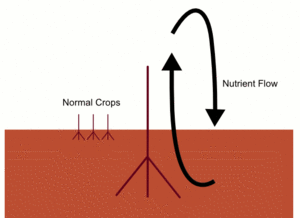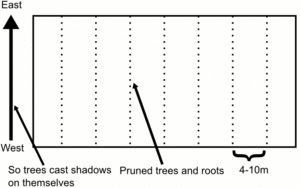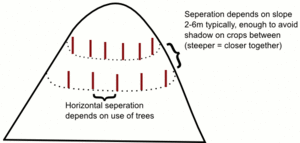
Agroforestry describes a variety of land-use systems, which optimize the benefits of biological interactions, created when trees and/or shrubs are combined with crops and/or livestock. It is associated with agroecology, polyculture and permaculture. Agroforestry systems may be implemented to increase yield, reduce inputs, or manage soil fertility and erosion. Trees and shrubs do compete with each other for sunlight but often require sunlight at different times. Several combinations and types of trees/shrubs, crops can be used, depending on the company and region.
Types of combinations[edit | edit source]
- Populus/Prunus/Juglans/Fraxinus/Robinia/Alnus/Castanea/Gleditsia/Sorbus with grass, maize or grain (Belgium)
- Hippophae/Juglans/Corylus (The Netherlands)
- Populus/Millet (England)[1]
Advantages[edit | edit source]
Agroforestry can have positive economic effects through better utilisation of land, and also environmentally as the different types of crop on the land work together and compliment each other.
Use of trees in agroforestry[edit | edit source]
- Enhancing soil fertility
- Through leaf fall
- Roots add nitrogen to soil through nodules in the roots (bacteria fixes nirogen -> nitrates)
- Recycling nutrients - Deep roots take nutrients from deep in soil and pass closer to surface. Useful if soil has been leached

- Nitrogen fixing trees - Compound leaves, flowers in pods, nodules (e.g calliandra, sespania, machuna, lusena, albizia, casuaniara, tithonia)
- Controlling soil erosion
- Acting as a windbreak
- Wind at start of the rainy season can destroy crops
- Need trees with strong deep roots (e.g. mangos, jack fruit, musambia, mysopsis)
- Use as supporting poles in building
- Live Fencing
- (e.g Lantana camara [aka Kapange], Kei apple trees, Cyprus [aka xmas tree], Ficus, Kilowa, Glyricidia, Bustani, Caliandra)
- Fruits, Fodder, Medicine, Fuel
- Medicinal trees - Moringa, neem, melia
- Fodder trees - calliandra (high protein content), lucana, glyvidia, titonia (for goats), ficus, avocado - Using these as a live fence and then pruning a section for fodder each day/week is a useful method for controlled live fences and regular fodder
- Trees help in supression of weeds
Managing agroforestry trees[edit | edit source]
Trees require water, air, light, materials - Hence potential competition (particularly when intercropping)
- Pruning - Also produces fodder. Trees regenerate and you can cut all the crown without killing the tree
- Lopping - Removing end of branches, reduces shadow
- Spacing of trees - (e.g mango - 12m)
- Prune the roots - (e.g calliandria - dig 1ft with hoe and cut the roots every season -> keeps nutrients at top of soil, encourages deep root growth)
Types of agroforestry arrangements[edit | edit source]
- Boundary planting. (see also Perimeter Crop Protection)
- Scattered within crops
- Woodlot - Stand trees in a separate area for use
- Windbreak

- Live fencing
- Compound trees - Fruit, ornamental, shade
- Buffer zone - To stop attack of crops by pests
- Alley cropping - On plains, plateaus

- Contour planting - On steep gradients stops erosion

Types of agroforestry systems[edit | edit source]
The following taxonomy of agroforestry systems is provided by Young (1997)[2]
- Agrosylivicultural (trees with crops)
- Rotational
- Shifting cultivation
- Managed tree fallows, including relay intercropping
- Taungya (crops followed by relay intercropping and short rotation forestry)
- Spatially mixed
- Trees on cropland
- Perennial-crop combinations
- Multi-strata systems (agroforests), including forest gardens, home gardens
- Spatially zoned
- Boundary planting
- Trees of erosion control structures
- Windbreaks and shelterbelts
- Hedgerow intercropping (alley cropping)
- Contour hedgerows
- Biomass transfer (cut and carry)
- Rotational
- Sylvopastoral (trees with pastures and livestock)
- Spatial mixed
- Trees on pasture (parkland systems)
- Perennial crops with pastures (including orchards)
- Spatial zoned
- Hedges and live fences
- Fodder banks
- Spatial mixed
- Trees predominate (see also taungya)
- Farm and village forestry
- Reclamation agroforestry
- Special components present
- Entomoforestry (trees with insects)
- Aquaforestry (trees with fish, mangrove aquaculture systems)
Challenges[edit | edit source]
Agroforestry is relevant to almost all environments and is a potential response to common problems around the globe, and agroforestry systems can be advantageous compared to conventional agriculture or forestry.[3] Yet agroforestry is not very widespread, at least according to current but incomplete USDA surveys as of November, 2013.[4][3]
As suggested by a survey of extension programs in the United States, some obstacles (ordered most critical to least critical) to agroforestry adoption include:[4]
- Lack of developed markets for products
- Unfamiliarity with technologies
- Lack of awareness of successful agroforestry examples
- Competition between trees, crops, and animals
- Lack of financial assistance
- Lack of apparent profit potential
- Lack of demonstration sites
- Expense of additional management
- Lack of training or expertise
- Lack of knowledge about where to market products
- Lack of technical assistance
- Cannot afford adoption or start up costs, including costs of time
- Unfamiliarity with alternative marketing approaches (e.g. web)
- Unavailability of information about agroforestry
- Apparent inconvenience
- Lack of infrastructure (e.g. buildings, equipment)
- Lack of equipment
- Insufficient land
- Lack of seed/seedling sources
Some solutions to these obstacles have already been suggested although many depend on particular circumstances which vary from one location to the next.[4]
See also[edit | edit source]
- Tree nursery - When a large number of trees is required in agroforestry, a tree nursery can be a used to produce many/strong saplings
- Permaculture zone 3 and/or 4
- Guild
External links[edit | edit source]
References[edit | edit source]
- ↑ Vilt magazine, Focus:Agroforestry
- ↑ Anthony Young, Agroforestry for soil mangement, 1997
- ↑ 3.0 3.1 "Agroforestry Frequently Asked Questions". United States Department of Agriculture. Retrieved 19 February 2014.
- ↑ 4.0 4.1 4.2 Jacobson, Michael; Shiba Kar (August 2013). "Extent of Agroforestry Extension Programs in the United States". Journal of Extension 51 (Number 4). Retrieved 19 February 2014.